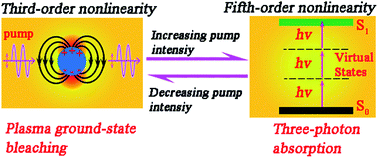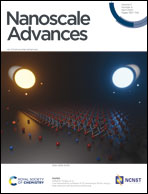Paradoxical combination of saturable absorption and reverse-saturable absorption in plasmon semiconductor nanocrystals†
Abstract
In heavily doped semiconductor nanocrystal systems, high-order nonlinearities including third-order nonlinearity and fifth-order nonlinearity can be tailored to manipulate light on the nanoscale due to the semiconductor intrinsic absorption and localized surface plasmon resonances. Here, by exploiting the nonlinear optical properties of broadly infrared plasmons in solution-processed aluminum-doped ZnO nanocrystals (AZO NCs) with a wide band-gap, we demonstrate that the competition between plasma ground-state bleaching (third-order nonlinearity) and three-photon absorption (fifth-order nonlinearity) is responsible for the transition between saturable absorption and reverse saturable absorption. Upon increasing the pump intensity, the third-order nonlinear coefficient decreases from −5.85 × 102 cm GW−1 to −7.89 × 10−10 cm GW−1, while the fifth-order nonlinear coefficient increases from 3.08 × 10−9 cm3 GW−2 to 15.8 cm3 GW−2. With aluminum-doped ZnO nanocrystals as a Q-switch, a pulsed fiber laser operating at the C band (optical communication band) was constructed. Furthermore, the relatively small temperature fluctuations (7.13 K) of the Q-switch indicate its application prospects in all-optical systems. Investigations on the intrinsic mechanism between high-order nonlinearity and the nonlinear absorption can promote the further development and applications of heavily doped oxide semiconductors in advanced nanophotonics.



 Please wait while we load your content...
Please wait while we load your content...